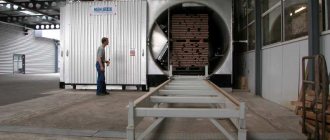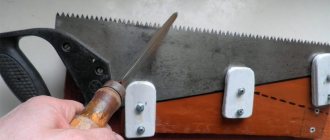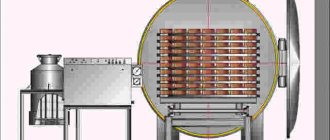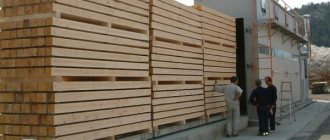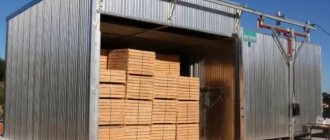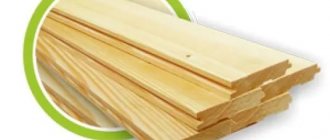Drying lumber and wood blanks has always been and remains the most important technological operation in the production of wood products. The process of reducing wood moisture content using an industrial method should be considered the main one - for several reasons. Firstly, because it is still manageable, and, secondly, it is much shorter than natural drying.
Controlling the drying process involves monitoring and regulating the evaporation of moisture from the surface of the wood. The intensity of evaporation is maintained by the temperature and humidity of the drying chamber environment.
By and large, a drying chamber is a complex of technological equipment designed specifically to remove excess moisture using thermal heating. The most important criterion for drying is reducing the amount of moisture while maximizing the preservation of the technological properties of wood.
"A C"
The current state of drying equipment at Russian enterprises can only be described as satisfactory. Sawmills and woodworking industries that have been operating for a long time use a large number of drying chambers of old designs that require significant modernization. And in some cases, cameras are only listed on the balance sheet, but do not work.
In order to properly dry lumber in such conditions, production workers spend enormous amounts of energy and labor. It turns out to be a kind of vicious circle. It is not possible to invest in the re-equipment of drying equipment due to the lack of necessary financial resources. As a result, the company does not have enough resources for effective growth.
Is modernization needed?
It is irrational to start re-equipment with the purchase of equipment. Old drying chambers built from bricks, blocks, panels and other building materials, as a rule, require major repairs of enclosing structures (walls, ceilings, doors). If this is not done, then further re-equipment will be a waste of money. Significant heat losses will again lead to increased energy consumption, and therefore will not reduce the cost of drying lumber. There is only one way out - to do repairs or reconstruction (depending on the condition).
The old fashioned way
Previously, sawmills and woodworking enterprises built dryers with high productivity, which were used mainly for drying lumber to transport moisture. These are continuous chambers (for example, TsNIIMOD-49, TsNIIMOD-32, TsNIIMOD-24, NB, models with zigzag circulation, SP-5KM, etc.).
If in such chambers, inherited from Soviet times, in accordance with modern requirements, they try to dry lumber to an operating humidity of 8-10%, then it will not be possible to achieve a good result. There will be a large percentage of defects, the wood will dry unevenly. You should not expect high-quality drying of lumber in chambers of outdated designs, which implement outdated technology (ejection, gas chambers).
Why is wood drying necessary?
After a tree trunk is cut down, the wood has a fairly high percentage of moisture content. However, during operation this level gradually decreases. If you use such raw materials in construction or manufacturing parts, you will not be able to avoid cracks and manufacturing defects. After all, drying will occur uncontrollably, under the influence of chaotic phenomena in the form of high temperatures, surges in air humidity and precipitation.
Therefore, the entire wood drying process must be strictly controlled or, at a minimum, the most suitable conditions for this must be created. It is possible to use various methods that may require a longer period to dry the rock (up to several years) and may be quick (less than a day). Also, when drying lumber, special devices, installations and equipped technical rooms are often required. In modern production, several methods are actively used, each of which has certain advantages and disadvantages.
Homemade
Some manufacturers of wood products do not pay enough attention to drying production, mistakenly believing that they can create a drying chamber with their own specialists, not caring at all about the fact that they do not have knowledge of the process technology and design of such equipment. Because of this, in such home-made drying kilns, problems arise in practice related to obtaining high-quality lumber.
When building it yourself, they are usually guided either by the experience of a neighbor who has built a similar one, or by information from advertising brochures of drying chamber manufacturers, and often simply by relying on their own experience. This is mainly done by small woodworking enterprises with relatively low needs for dry lumber.
In the homemade version, the dryer is a closed heated room (usually with smooth or finned heating pipes placed on the walls) with a door for loading lumber. Exhaust air ducts are provided to release moist air. Often there is not only an automation system for controlling parameters, but also simple measuring instruments for visual monitoring of temperature and humidity of the environment. At the same time, the drying process is carried out almost uncontrollably, with the absence of any technology and modes.
At the first glance at such a “drying chamber,” one immediately notices the clearly insufficient circulation, unorganized movement of the drying agent in the chamber, lack of heat supply, and improperly organized supply and exhaust ventilation with the environment.
Lumber in such conditions turns out to be of poor quality. There is great unevenness of drying, a large number of defects - cracks, warping of assortments. In addition, the duration of the drying process in them is excessively extended. The material constantly has to be reloaded and sent back to dry.
Naturally, with a reasonable approach, you can build a drying chamber yourself, but still, in order not to make a large number of miscalculations in the design, it is better to contact specialized organizations, specialists in wood drying.
Advantages and disadvantages
The main advantages of chamber drying include:
- drying of raw timber to a moisture level of more than 6%
- implementation of constant monitoring, as well as the possibility of changing the drying process. For each type of wood, you can choose the most profitable drying mode
- saving time on preparing materials for processing and reducing production space
- The drying period is much shorter than in the case of atmospheric drying. The resulting materials occupy a smaller area
- lumber becomes immune to rot and blue stains during the drying process.
The most significant disadvantage is the high cost of equipping dryers and significant heat costs for heating the air.
The most common causes of wood defects during drying.
| Defect/defect | Drying too quickly, relative humidity too low | Drying too slow, relative humidity too high | Incorrect stacking | Operational errors | Factors related to wood properties |
| Surface cracks | * | * | *(1) | *(2) | |
| End cracks | * | ||||
| Internal cracks | * | *(3) | *(2) | ||
| Chips and splinters | * | *(4) | |||
| Kink | * | *(5) | |||
| Blue fungal spots | * | * | |||
| Mold, powdery mildew | * | * | |||
| Rot | * | * | |||
| Coffee or brown fungal stains | * | * | * | *(2,5) | |
| Stains from spacer strips | * | *(6) | |||
| Traces of surface carving with teeth | *(7) | ||||
| Twisting | *(8) | ||||
| Guttering | * | *(9) | *(10;11) | ||
| Arc bend | * | *(8) | |||
| Planar bending | *(4) | ||||
| Diamond shape, ovality | *(11) | ||||
| Warping after drying | *(12) | ||||
| Uneven drying | * | * | *(13) | ||
| Excessive humidity | *(14) | ||||
| Excessive dryness | *(14) | ||||
| Surface hardening | *(14) | ||||
| Unthickened resin | *(15) | ||||
| Resins under annual rings | *(2) | ||||
| Loss of flavor | *(16) | ||||
| Weakened bitches | * | *(17) | |||
| Cracked knots | * | ||||
| Cracked core | *(11) | ||||
| Raised fibers | *(18) | ||||
| Broken and torn fibers | * | *(19) | |||
| Planing scuffers | *(9) | ||||
| Bad smell | *(2) | ||||
| End splits after drying | *(11) |
Note. Numbers in the table:
- The initial temperature is too high - moisten the dried surface of the wood again.
- Bacterial contamination of wood.
- Temperature too high with wood moisture content > 30% - moisten the dry surface.
- Tension in wood, compression of wood, young wood.
- Enzymatic oxidation reaction under the influence of temperature, atmospheric humidity and moisture content of wood.
- Wet spacer bars or spacer bars that are too wide.
- Temperature too high.
- Cut at an angle to the grain.
- Wood that is too dry and surface hardened.
- Thin wood lumber.
- The difference between radial and tangential (lateral) shrinkage.
- Change in the moisture content of wood after drying; the moisture content of wood differs from the RVS of air.
- A mixture of different tree species, small and large wood, butt and cut logs, different air speeds.
- Bad samples, incorrect moisture content measurements, faulty equipment, errors in tables or measurement methods.
- Softwoods only: Use temperatures of 52°C or more.
- Do not allow the temperature to exceed 30°C.
- The knot in the wood was held on by resin.
- The difference in the density of spring and summer wood and inconsistency with equipment settings.
- The moisture content is still too high or too low: setting up the equipment.
A Question of Choice
Of course, the current state of lumber drying in Russia is not determined solely by the above. When organizing new productions, as well as when modernizing existing ones for the production of competitive high-quality wood products, they try to equip the production with modern equipment, including modern drying chambers. And it is right. However, here it should be noted that when investing in new production, entrepreneurs put the choice of a drying chamber in last place. Caring about technology and purchasing woodworking machines, for some reason they believe that choosing the necessary drying chamber will not be difficult. But this only seems to be a simple matter. There are many nuances that need to be taken into account.
You need to know the nuances
Recently, a trend has developed in the forestry industry that investors are investing in production that brings profit in the short term. Because of this, recently they have been trying to build drying chambers in the form of easily and quickly erected insulated metal structures. But here too the question of choice arises. When considering various types of construction (convective, condensation, aerodynamic, vacuum), as a rule, they focus on cost.
Some manufacturers of drying chambers, in an effort to sell their product, do not particularly educate the client, praising their chamber.
Entrepreneurs often order a chamber with a large loading capacity (60-100 m3), mistakenly believing that they will be able to load all the material into it at the same time, including different thicknesses, and in the future it turns out that, having a large chamber, they underload it and violate the technological process.
Type of heating
Today, a fairly common phenomenon is the desire of most owners of drying kilns and those who are just planning to purchase one to establish heat supply from a hot water boiler that runs on sawmill and woodworking waste. At the same time, many have little idea about the required amount of waste and consider this option to be the cheapest. Maybe in the case of high-power boiler houses of 1-2 MW or more, this is true. Moreover, such boilers are also considered as a wood waste recycler at their enterprise.
In fact, when organizing a small boiler room for autonomous heat supply to the drying chamber, it is more economical to use electric heating or water heating boilers running on gas, diesel fuel and coal. The automatic burner of gas boilers does not require the presence of an operator. In regions with low electricity costs, electric boiler systems are naturally common. Automation of the drying and heat supply process affects the cost reduction, therefore, in the end, it turns out cheaper, or at least is at the level of heating the chamber with woodworking waste.
Which drying chamber manufacturer to choose
I deliberately did not touch on the names of specific enterprises in the article, so that the review would not focus on any specific company. But at the same time, without mentioning the manufacturers of wood drying chambers, the review would be incomplete and not so useful. Moreover, the most common question that I get asked on the Internet and in real life is who exactly can I recommend.
It is important not to forget that in addition to the camera’s characteristics and its price, good service support is also needed. I remember how in one production we had a glitch in the program and the drying process stopped not only in one chamber, but in the entire complex, because... control was unified and came from one computer. We couldn’t restore anything on our own; we needed a company representative, who, by the way, arrived only after 2 (two!) months. I won’t say what happened to the lumber and how many losses the company suffered - it’s clear. But I never recommend this manufacturer in private conversations. By the way, they are still working and their website functions well and attracts customers.
I won’t write the name of this production here; now and then we hear lawsuits for libel on the Internet and so on. Then I don’t want to run around to the courts and prove that I didn’t slander, but that I told my experience. Among the worthy options presented on the market today I can highlight:
- Kovrovskie Kotly is an old, reliable company that has been on the market for 20 years. Drying chambers are supplied complete with self-produced boilers that operate on wood chips and sawdust. There are two types of convection chambers: periodic front-loading and continuous drying chambers. It can be noted that the quality of drying is quite good.
- Mülbock-Wanicek is an Austrian company that has been operating on the market since 1952. It has managed to establish itself throughout the world. It is worth keeping in mind that the equipment is not cheap.
In principle, from these you can choose what you need, depending on your budget.
Vector for deep processing
The fact that today wood processors are trying in one way or another to organize drying production at their enterprises indicates a desire to engage in deep wood processing, which brings great profit.
An increase in duties on the removal of round timber will lead to an even greater increase in the volume of deep wood processing in Russia. The development of the industry will inevitably affect a significant increase in drying capacity. The prospect for the development of wood drying in Russia as one of the fundamental stages in the production of high-quality wood products, which are used in many industries.
How to properly dry wood so that cracks do not appear in it?
Proper wood drying processes are the key to obtaining high-quality material, without the formation of various cracks and other deformations of the wood.
The arrows indicate the process of evaporation of excess moisture from wood
Drying wood under the influence of atmospheric air assumes the presence of exposure to weather conditions, therefore a change in appearance may occur under the influence of strong sun or rain.
Ventilated wood should be placed under awnings. The drying process should be organized immediately after sawing the wood. It is necessary to correctly position the stacks of wood, create a gap between the stack and the ground surface of at least five hundred millimeters, using a variety of pads for this.
Air channels should be installed between rows in stacks for a more uniform drying process. In order to prevent cracking processes, the ends of the wood should be treated with drying oil or any type of oil paint.
Automatic drying processes are simpler in this sense, since the necessary data is already built into the programs.
In automatic dryers, a necessary condition for avoiding the deformation process is strict adherence to wood drying technology.
Different approach
What is important, in my opinion, is the correct choice of drying chamber design, taking into account the performance and quality of drying, and not cost, which is the main criterion today. For example, for a large sawmill producing tens of thousands of cubic meters of materials per year, it is necessary to select chambers with high productivity (drying tunnels, condensation dryers, etc.).
For those entrepreneurs who work with difficult-to-dry hardwood (including exotic) wood, and usually process small volumes, you should pay attention to vacuum dryers, microwave-heated chambers, ultrasonic and the like. With these special methods, it is possible to dry valuable types of wood in blanks efficiently and quickly.
When choosing a specific chamber design, you need to clearly understand what you want to dry and for what purpose.
How long does it take to dry?
The degree of drying on an industrial scale is checked using a device (electric moisture meter). At home, the completion of the process is determined by squeezing the shavings in a fist. Several thin layers are removed from the material. If the tester is cracked, then the raw material is ready.
The rate of moisture evaporation depends on the technology used, the type of wood and weather conditions. Understanding how long it takes for a 50 mm board to dry, you can choose the optimal method. In summer, with moderate humidity, deciduous species grow naturally in 2.5 weeks. In spring and autumn, fifty is dried for 40-60 days.
Source gbbrfcu.org
Hardwood takes a very long time to dry in the open air - from 1 to 3 years. To speed up the process, I recommend using a camera. Boards up to 50 mm thick are ready in 50-60 days. It is worth adjusting the operation, otherwise the valuable material will crack and deform.
Are imported ones better?
I cannot agree with the opinion that the prospect for the development of wood drying in Russia lies only in the acquisition of imported drying chambers. The existing stereotype that imported dryers, although much more expensive in cost, allow drying to be of higher quality than domestic ones, is far-fetched and does not have strong and unambiguous evidence. Often, in confirmation of this, not the best example is given with the domestic and foreign automobile industry. Then the question arises: is it even possible to dry qualitatively not in imported dryers? In my opinion, it is possible to dry, if not better, then at exactly the same quality level, in domestic drying chambers.
The main advantages of imported drying chambers are their housing, consisting of aluminum panels, as well as automatic control systems that ensure high-quality drying.
However, the body of the drying chamber made of aluminum can be manufactured with high quality by most domestic enterprises. In addition, Russian manufacturers also complete their designs with imported components (fans, heat exchangers, control systems, etc.). I am confident that domestic companies are quite capable of developing and manufacturing new competitive designs of drying chambers.
In practice, when using imported chambers, problems arise, most often associated with the operation of the automatic drying process system. In most cases, lumber is dried according to factory programs installed in the control unit, and therefore completely rely on automation. Even with a minor malfunction in its operation, personnel are lost, and not everyone knows how to adequately control the camera in manual mode.
About the cycle
During the drying process of lumber, the outer layers heat up and dry faster than the inner layers, and if they dry faster, they dry out faster. Well, if the middle has not yet dried out but the outside has dried out, then tension and cracks arise.
The thinner the board, the higher the average temperature can be (and, accordingly, the drying conditions of the wood can be harsher), since thinner lumber does not crack as much as thick lumber, due to faster heating of the middle.
The total cycle time of the drying process can be divided into:
- Auxiliary time:
- Loading the dryer, closing the gate.
- Unloading.
- Main time:
- Warming up the dryer and boards. At this stage, the equipment warms up very slowly, water is supplied through the nozzles, and air humidity reaches 90%. The wood gets wet and warms up. This stage allows you to relieve surface tension in the wood and equalize humidity and temperature across the entire cross-section of the wood.
- The average air humidity gradually decreases, but the water supply nozzles periodically open and the air humidity rises, this is done to relieve tension in the upper layers of wood.
- Moisture and heat treatment. There is a slight moistening of the outer layers of wood, and air humidity increases slightly.
- Purge. Air circulation, cooling of boards.
Buy or restore?
Again, returning to the topic of modernization, it should be noted that there is not always a need to buy a new drying chamber, demolish the old one and build a new one. If the condition of the drying chamber enclosing structures is in satisfactory condition, then reconstruction or equipping the dryer with modern equipment is a good option. Of course, if serious restoration is required, then the cost of reconstruction may be the same amount as the construction of a new drying chamber, then reconstruction is not advisable.
Often the need for reconstruction is dictated not only by the wear and tear of equipment or the destruction of fences, but by the task of reducing energy costs and improving the quality of drying or increasing the productivity of the dryer.
